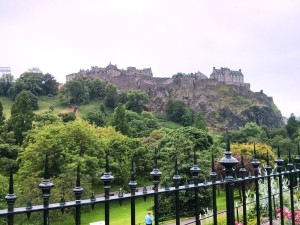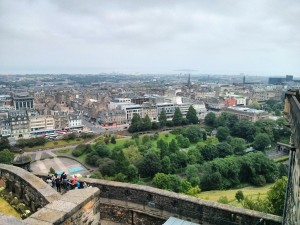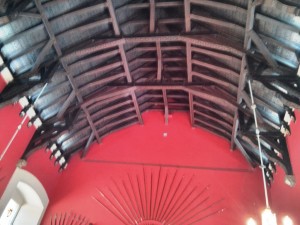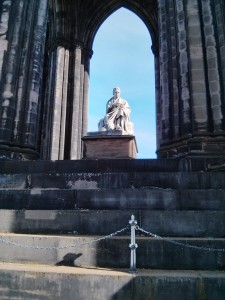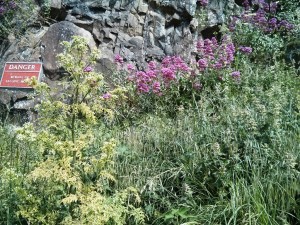Tuesday, June 17
Our train didn’t leave Windermere until 1. After our pre-breakfast hike, there wasn’t much more we could do, so we took it easy in the morning. This was the first time we were on a train that was late. Our first train was on time as usual. Our second train had only four stops. The penultimate stop was in the outskirts of Edinburgh. For some reason, they held us up just before we pulled into the station. As a result, we were a few minutes late on arrival. I wish transportation in the US could be this good. We made a wrong turn walking to our guest house and walked an extra block. But we were checked in by 4:30. Our plan was to visit Edinburgh castle the next morning, so we decided to walk up to the castle before going to bed. It turned out that we had to climb a significant hill. Poor Danita overdid the walks a little bit. We were crossing a street where the light was turning. I told Danita to hurry up. But her calves were so sore, she just didn’t have any “hurry up” left. We were both pretty tired by the time we got back to our guest house.
Wednesday, June 18
We spent 5 hours at Edinburgh Castle. They offer an introductory tour, which was both was amusing and informative. Then we used the audio tour to visit the rest of the castle. It isn’t one castle so much as several, that were built on top of each other, or were significant expansions or additions as the castle was used for different purposes over the years. The only complete building from the midevael castle was St. Margeret’s Chapel, which dates back to 1150 (not quite as old as the oldest part of the Tower of London).
The most impressive building was the great room. This building was re-done in the Victorian era, with very predictable results. But the amazing part of the building was the oak roof trusses, which were original. It was a huge building. The roof was supported only by the walls. The beams were all hand-fitted and pegged. It is an amazing roof. The Tower of London was breached only once — by a bunch of peasants who were mad at the king and especially some bishop, who they thought was taxing them too much. (They ended up beheading the bishop.) In contrast, Edinburgh Castle was breached several times over the years, as the English and Scottish went back and forth over who ruled Scotland. The contrast between Edinburgh Castle and the Tower of London is huge, but no where larger than the Crown Jewels. The crown of Scotland is the oldest crown used by a monarch in Europe. But it has no significant jewels. They have a scepter and a sword, which were both gifts from England (given at different times). The only other thing they have in their Crown Jewels room is a stone, used by King Robert the Bruce as a throne when he was crowned king. (Think “Bravehart”, but without all the Mel Gibson histrionics.)
We spent the rest of the day wandering down the Royal Mile. We visited St. Giles Cathedral. Our last attraction was the Real Mary’s King Close. “Close” is the word used for a narrow street. We were able to walk down a couple of Closes later on. It’s easy to touch the walls on both sides of the Close at the same time. When Edinburgh built a new city council chambers building, they simply built it on top of the existing buildings in the area, effectively burying Real Mary’s King Close, using the walls from those buildings as a free foundation for the new building. There was no reason not to do this. The area was a slum at the time. Some enterprising individuals opened several of the buried buildings to show how the poor, middle class, and upper-middle class lived in the 16th century. I thought that 16th century life in Stratford-Upon-Avon was hard and lacking in conveniences, but not so bad overall. I would not want to live in a city in the 16th century. Apartments were very small. Limited land inside the city walls meant that houses were several stories high. Most people had to walk up and down several flights of steps to get to their apartments, of course carrying all their food, water, and other supplies up those stairs. And urban sanitation was absolutely abysmal. They said the average life expectancy was 40. Given the infant death rate, that meant a significant number of people lived to 60 or more. But given the living conditions, I don’t see how anybody managed to live that long.
Thursday, June 19
We spent our morning finishing the walk down the Royal Mile, then visited the Edinburgh City Museum (not much of a museum, but it is free) and Holeyrood Palace, the royal residence when the queen is in Edinburgh. It’s also where Mary Queen of Scotts lived when she was queen of Scotland, and where her son James was born. James went on to be the first person who was king of both England and Scotland (and also France, but nobody around here much cares about France). We heard a lot about Scottish history at the castle and again at the palace. Even the Scottish guides couldn’t make Mary Queen of Scotts look good.
The weather was so nice we decided to spend the afternoon outside. We walked up Aurthor’s Seat. This is an extinct volcano not far from the palace. It takes some effort to walk up, but the view of Edinburgh is the best you can get. While we were up there, we had a good view of Calton Hill. We saw Nelson’s column, then noticed something that looked like a Roman Ruin right next to it. We hadn’t read about this in the travel literature, so we looked it up. It turned out to be the National Monument for the soldiers that died in the Napoleanic wars. Unfortunately, they ran out of money and it was never finished. It is sometimes called “Edinburgh’s Folly”, and other times called names even less flattering.

